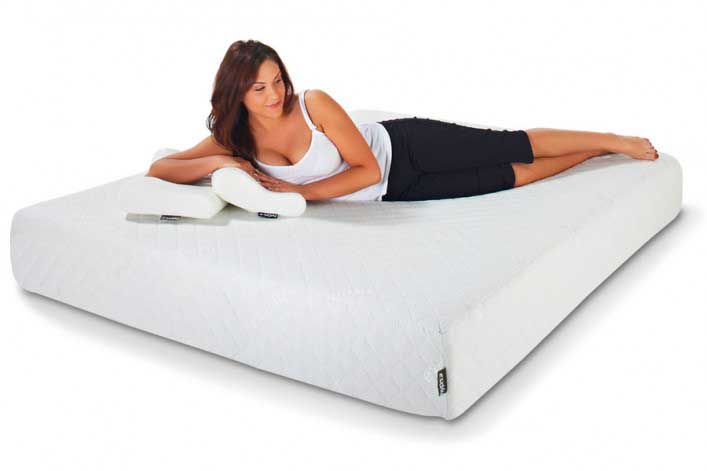When you go to mattress stores, you usually hear or see sellers advertise blah blah like 1/3 of your whole life is spent on sleep and it’s a wise investment in comfortable mattress. They are right indeed. There are several types of mattress on the market like innerspring mattress, memory foam mattress, etc. All types can provide a comfortable sleep that you need. This article isn’t to teach you how to choose a comfortable mattress as you can find the guide on many websites. Different mattresses have difference features. Here is a post to help you know more about mattress before you go to the market.
Memory foam
 Memory foam mattress is a magical type of mattress because it maps your body shape when you sleep on it. It has a memory like we do but very short one. The foam remembers where you sleep after you get out of the bed or change position. Actually, it shows your body impression when you sleep and takes about several seconds to recover its shape when you get out of it. It conforms to your body and help find right support for every part. Therefore, many people recommend it to backaches sufferers. It does a great job in relieving back pain. Memory foam mattresses vary in thickness and density. Different thickness and density make it feel different, firm or soft.
Memory foam mattress is a magical type of mattress because it maps your body shape when you sleep on it. It has a memory like we do but very short one. The foam remembers where you sleep after you get out of the bed or change position. Actually, it shows your body impression when you sleep and takes about several seconds to recover its shape when you get out of it. It conforms to your body and help find right support for every part. Therefore, many people recommend it to backaches sufferers. It does a great job in relieving back pain. Memory foam mattresses vary in thickness and density. Different thickness and density make it feel different, firm or soft.
Memory foam has a unique feature, temperature sensitive. It’s very sensitive to temperature. In warm days, the mattress gets a little softer; in cold days, it becomes firmer. The higher the foam density the more apparent it becomes. This feature enables mattress to respond fast to your body temperature. Memory foam mattress has two primary drawbacks. One is this type of mattress retaining warmth to make hot sleepers uncomfortable. These days, foam manufacturers are infusing gel beads into the foam to address this issue. It lowers surface temperature of the bed to some extent, but doesn’t eliminate the issue. The second issue is offgassing. Most owners of memory foam mattress complain the mattress comes with a strong chemical odor and some even linger for a month.
Memory foam mattress usually consists of two parts, comfort layer and support base. Both parts are foam and the difference is the foam density. The comfort layer, also called upholstery layer, is using more than 2.5lb foam, while the foam base is less than 2 lb.
Memory foam pros & cons
Pros:
- Reduce pressure points and help back pain
- Limit motion transfer
- Provide target support for each piece of the body
Cons:
- Warmer surface temperature
- Off-gassing
Innerspring
Innerspring mattresses are made up of hundreds or thousands of steel coil springs. The coil springs inner bed support people. Two factors related to the coils decide most of the mattress like support and durability. One is the gauge of the coils. This specification affects support degree, firm or soft support. You could see many ads saying “our mattress is using 13.5 gauge steel spring coils”. The high the gauge parameter, the thinner springs and more resilient the mattress is. Otherwise, the springs are thicker and the mattress is firmer. Another factor is the type of coils. There are four coil types out there but two types are popular, traditional coils and pocketed springs. Coils in pocketed spring mattress are individually encased in fabric pocket. Coils aren’t wired together but bearing pressure independently. Every coil ensures the pressure it’s supposed to do and doesn’t affect neighbors. This type of coils reduces motion transfer to the other on the bed. More importantly, it can provide appropriate support for the whole body.
Now, manufacturers are adding various toppers on the innerspring mattress to increase comfort like foam top and latex top.
Innerspring pros & cons
Pros:
- Helpful to back pain sufferers
- Little motion transfer
- Retain less heat than memory foam
Latex
Latex mattress has all advantages of memory foam mattress and performs better than foam mattress. It’s not temperature sensitive but breathing very well, warm in winter and cool in summer. It’s more supportive and offering bouncy support, great for back pain. The latex mattress, especially all natural latex, is hypoallergic and naturally resistant to bacteria, mildew, mold and dust mites. It doesn’t hold body heat or give out bad smell. So more and more people recommend it and consider as the best mattress.
Latex mattress has three different variations, all latex, latex over foam and foam over latex. The first type is the best and you can experience benefits latex brings but if you want to have a latex bed you should avoid the last choice. What you sleep on isn’t even latex.
Latex pros & cons
Pros:
- Hypoallergic
- naturally resistant to bacteria, mildew, mold and dust mites
- Help bad back
- No chemical smell

